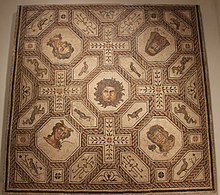
Mosaic
A mosaic is a pattern or image made of small regular or irregular pieces of colored stone, glass or ceramic, held in place by plaster/mortar, and covering a surface.[1] Mosaics are often used as floor and wall decoration, and were particularly popular in the Ancient Roman world.
This article is about a decorative art. For other uses, see Mosaic (disambiguation).
Mosaic today includes not just murals and pavements, but also artwork, hobby crafts, and industrial and construction forms.
Mosaics have a long history, starting in Mesopotamia in the 3rd millennium BC. Pebble mosaics were made in Tiryns in Mycenean Greece; mosaics with patterns and pictures became widespread in classical times, both in Ancient Greece and Ancient Rome. Early Christian basilicas from the 4th century onwards were decorated with wall and ceiling mosaics. Mosaic art flourished in the Byzantine Empire from the 6th to the 15th centuries; that tradition was adopted by the Norman Kingdom of Sicily in the 12th century, by the eastern-influenced Republic of Venice, and among the Rus. Mosaic fell out of fashion in the Renaissance, though artists like Raphael continued to practice the old technique. Roman and Byzantine influence led Jewish artists to decorate 5th and 6th century synagogues in the Middle East with floor mosaics.
Figurative mosaic, but mostly without human figures, was widely used on religious buildings and palaces in early Islamic art, including Islam's first great religious building, the Dome of the Rock in Jerusalem, and the Umayyad Mosque in Damascus. Such mosaics went out of fashion in the Islamic world after the 8th century, except for geometrical patterns in techniques such as zellij, which remain popular in many areas.
Modern mosaics are made by artists and craftspeople around the world. Many materials other than traditional stone, ceramic tesserae, enameled and stained glass may be employed, including shells, beads, charms, chains, gears, coins, and pieces of costume jewelry.
Mosaic is an art form which uses small pieces of materials placed together to create a unified whole. The materials commonly used are marble or other stone, glass, pottery, mirror or foil-backed glass, or shells.
The word mosaic is from the Italian mosaico deriving from the Latin mosaicus and ultimately from the Greek mouseios meaning belonging to the Muses, hence artistic. Each piece of material is a tessera (plural: tesserae). The space in between where the grout goes is an interstice. Andamento is the word used to describe the movement and flow of tesserae. The 'opus', the Latin for 'work', is the way in which the pieces are cut and placed.
Common techniques include:
Robotic manufacturing[edit]
With high cost of labor in developed countries, production automation has become increasingly popular. Rather than being assembled by hand, mosaics designed using computer aided design (CAD) software can be assembled by a robot. Production can be greater than 10 times faster with higher accuracy. But these "computer" mosaics have a different look than hand-made "artisanal" mosaics. With robotic production, colored tiles are loaded into buffers, and then the robot picks and places tiles individually according to a command file from the design software.[39]




















